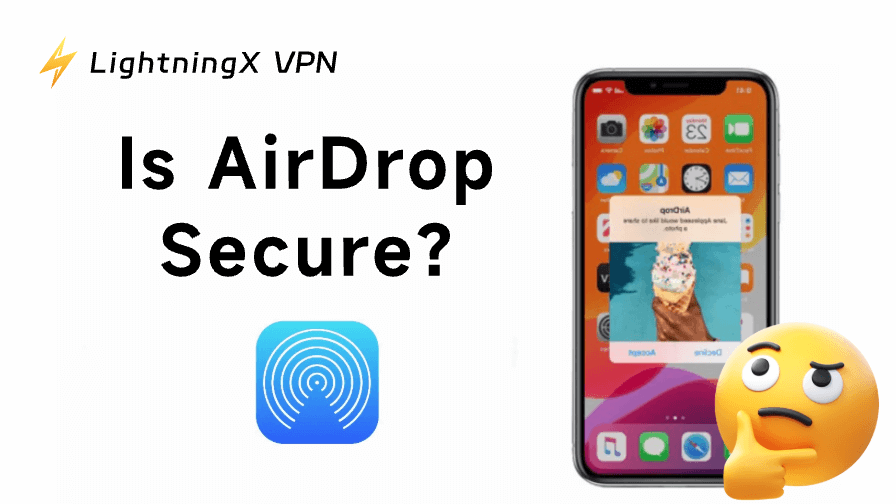AirDrop is a convenient tool for Apple users to share files between their devices, like iPhones, iPads, and Macs. However, even though Apple’s advanced technology protects the transferring process, users might still have doubts: Is AirDrop secure to use? Well, this is worth exploring. Next, we’ll discover the security levels of AirDrop and provide measures to employ the feature securely.
Working Principle of AirDrop
AirDrop is Apple’s proprietary feature that enables users to share various types of files directly between their devices. Its effective range is usually around 9 to 10 meters, since it relies on Bluetooth for device discovery.
Using AirDrop requires both Bluetooth and Wi-Fi to be turned on simultaneously. Bluetooth uses the Bluetooth Low-Energy (BLE) technology to discover nearby devices, while Wi-Fi is used for file transfer, utilizing a peer-to-peer Wi-Fi direct connection to send files. However, there’s no need to connect to an actual Wi-Fi network. Just turn on the Wi-Fi function.
Related: How to Airdrop Photos, Videos, etc. on iPhone/iPad/Mac
How Secure Is AirDrop? – Compare Its Security Strengths and Risks
Security Strengths of AirDrop
Considering data encryption and privacy settings, AirDrop itself is safe to transfer files.
First, AirDrop employs end-to-end TLS encryption to protect the complete file-sharing process. Strangers without permission cannot gain access to your files and data in AirDrop mode.
Second, AirDrop only works over short distances. This is because devices discover nearby devices via Bluetooth, then establish a peer-to-peer Wi-Fi connection for the actual transfer. This direct connection operates independently of the main Wi-Fi network, so network administrators cannot see your activity.
Third, AirDrop allows you to limit or decide the mutual transfer targets. You have the choice to prevent any malicious activities from bothering you.
Although these security measures provide significant protection for user data, certain potential risks remain.
Security Risks and Vulnerabilities
Most of the risks with AirDrop happen when you don’t restrict who can send you files or when you accept files without checking the content.
1. Personal data exposure
AirDrop encrypts the files you share, but it can still reveal some personal information when checking for nearby contacts. In Contacts Only mode, your device sends an encrypted version (hash) of your email or phone number to see if the recipient is in your contacts.
While these hashes aren’t plain text, a skilled attacker with enough computing power could potentially reverse-engineer them to uncover your contact details.
There have even been reports of this method being used in real-world scenarios. That said, carrying out such an attack is extremely difficult in practice.
2. Malware or virus acceptance
Another security risk of AirDrop is the possibility of receiving files that contain malware or viruses, especially on Macs. Cybercriminals often disguise harmful files as seemingly harmless documents, images, or other formats to trick users into opening.
On a Mac, malicious AirDrop files can be downloaded directly to your computer. Once triggered, they can compromise your Mac.
Depending on the complexity of the malware, it could steal personal information from your device, access other devices connected to the same network, or even spread via Wi-Fi to further exploit security vulnerabilities.
Therefore, please be cautious with AirDrop files and only accept content from people you know and trust.
3. Man-in-the-Middle (MITM) Attacks
The third potential security risk of AirDrop is the man-in-the-middle (MITM) attack, where a malicious actor poses as the sender to the recipient or as the recipient to the sender, so they can capture or even modify the transmitted data anonymously.
However, AirDrop’s TLS encryption technology is not easily cracked. Successfully executing a man-in-the-middle attack requires advanced technical skills and equipment, as well as significant effort.
For everyday users sharing typical files like photos, emojis, or documents, the effort and resources an attacker would need far outweigh any potential payoff. As a result, while MITM is a theoretical risk, ordinary AirDrop users are unlikely to encounter it.
Further reading: Why Is My AirDrop Not Working? Fixes for Seamless Sharing
Safety Tips for Using AirDrop
Here are some good practices to safely use AirDrop.
Set AirDrop to “Contacts Only” or “Receiving Off”: Most time, it’s better to avoid leaving AirDrop set to Everyone in public places. This prevents strangers from sending unsolicited files to your device. Even though you want to use AirPods in public spaces, try avoiding using AirDrop in crowded areas like Airports, cafes, and schools.
Only Accept Files from Trusted Sources: Even if a file looks harmless, it could contain malware. So, you should only accept AirDrop transfers from people you know.
Keep Your Device Updated: The updated iOS or macOS often have the latest security patches and fixes, while outdated versions are easier to attack by hackers.
Turn Off AirDrop When Not in Use: Disabling AirDrop when you don’t need it minimizes exposure to potential attacks.
Monitor Unusual Activity: If you notice unexpected files or behavior, investigate immediately and consider running a security scan on your iPad, iPhone, or Mac.
Tip: In addition to being vigilant against malicious activity when enabling AirDrop, you can also take steps to protect your privacy while browsing the internet. For instance, using a VPN prevents your real IP address and browsing history from being exposed to lurking hackers. LightningX VPN is an excellent choice, featuring robust encryption technology that effectively hides your sensitive information. It currently offers a free trial for new users.
Is AirDrop Secure – FAQs
Q: What is the risk of AirDrop?
AirDrop has three main potential risks, including malware or viruses, man-in-the-middle attacks, and personal information leaks.
Q: Can someone get your info from AirDrop?
Strangers could potentially access some of your information if AirDrop is set to Everyone. Keeping AirDrop set to Contacts Only or turning it off when not in use makes it much safer.
Q: Can AirDropped files be traced?
Direct tracing of AirDropped files back to the sender is difficult because AirDrop uses peer-to-peer Wi-Fi and end-to-end encryption. The files don’t go through the internet or Apple’s servers, so there’s no central log of the transfer. However, if someone knows your device name or is physically nearby when the transfer occurs, indirect tracing is possible.
Q: Can you check someone’s AirDrop history?
No, you cannot directly check someone else’s AirDrop history. AirDrop files don’t go through Apple’s servers. This means there’s no central log that can be accessed by others.





















